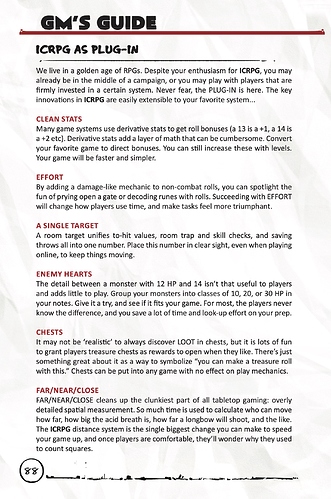Here are a few thoughts I posted a while back:
I’ve run two 5e campaigns with ICRPG mechanics on the DM side and normal 5e rules on the player side. On the DM side, I used a single target number; made all of the monsters have hit points in groups of 10 and a single bonus for all rolls; used timers; and began presenting content in discrete spaces or “rooms,” except for an occasional dungeon crawl. I slowly introduced concepts like Effort: “Give me a d6 of effort to pick that lock,” which is no different than doing 10 damage to chop down a door (illustrated in the DMG). For enemies, I just made up their abilities and made players making saving throws against “powerful spells,” which they are used to seeing in 5e anyway (saving throws against spells). I also used the ICRPG loot tables. Again, totally compatible, and no one was the wiser. On the player facing side, they all just leveled up as normal. It was honestly super easy with no major changes required, and it made my life waaaaay easier.
If the group seemed receptive, I would totally introduce the Easy/Hard mechanic instead of advantage/disadvantage. And the piece that would seal the deal, I think, would be the Easy roll after a failure. No one gets advantage that often, ever, in 5e, and so I think you could safely add that piece and be playing ICRPG.
For the record, I successfully converted one of my groups fully to ICRPG. Once I had all of the above, I firmly established effort. Then, tied to effort, I made all weapons do D6. After that, I removed skills and just had players roll their stat bonuses. Then I re-tooled hit points to an even number and introduced hearts. I slowly reskinned player abilities in terms of ICRPG terms. The final piece was converting magic to a list of simple spells and a roll-to-cast system. That final hurdle was the hardest, as casters get particular. But once I showed them that they could basically perform a ton of cool effects, then I had them. The total conversion to ICRPG took probably 10 weeks, adding a small new piece at a time. Towards the end, I collected their character sheets and returned new ones to them with everything written out, and it made all the difference. But, if you are going to go down this road, make sure your group is ready for it. My other group told me flatly: I don’t want to play ICRPG; I want to play 5e. Fair enough. You’ll be playing that. I’ll be playing ICRPG on my end.

